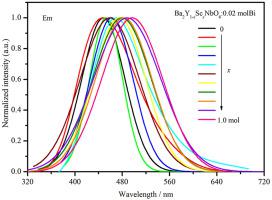Journal of Rare Earths ( IF 4.9 ) Pub Date : 2021-09-10 , DOI: 10.1016/j.jre.2021.08.021 Zhihua Gao 1 , Fengyan Fu 1 , Lili Niu 1 , Min Jin 2 , Xiaohong Wang 1

|
Here, we report a series of Bi3+-doped Ba2Y1–xScxNbO6 (0 ≤ x ≤ 1.0 mol) phosphors by using the traditional high temperature solid-state reaction. To achieve the structural and photoluminescent (PL) information, several experimental characterizations and theoretical calculations were carried out, including X-ray diffraction (XRD), Rietveld refinement, UV-visible diffuse reflectance and PL spectra, temperature dependent PL spectra, and density functional theoretical (DFT) calculations. The XRD results show that the Bi3+-doped Ba2Y1–xScxNbO6 samples belong to the double-perovskite phase with a cubic space group of Fm3̅m, and the diffraction positions shift toward high diffraction angle when the larger Y3+ ions are gradually replaced by the smaller Sc3+ ions. In addition, the refined XRD findings show that the Bi3+ ions tend to substitute the Y3+ and Sc3+ sites in the Bi3+-doped Ba2Y1–xScxNbO6 (0 < x < 1.0 mol) solid solutions. The PL spectra show that the emission positions of the solid solution samples tune from 446 to 497 nm with the increase of Sc3+ content, which can be attributed to the modification of crystal field strength around Bi3+ ions. Moreover, there is energy transfer from the Ba2YNbO6 host to Bi3+ ions, which is dominated by a resonant type via a dipole-quadrupole (d-q) interaction. The Ba2Y0.6Sc0.4NbO6:0.02 molBi3+ shows the strongest PL intensity under 365 nm excitation, with the best quantum efficiency (QE) of 68%, and it keeps 60% of the room temperature emission intensity when the temperature increases to 150 °C, meaning that the Ba2Y0.6Sc0.4NbO6:Bi3+ features excellent thermal quenching of luminescence. By combining this optimal sample with a commercial red-emitting Sr2Si5N8:Eu2+ phosphor, and a commercial 365 nm UV LED chip, a white LED device, with the color temperature (CT) of 3678 K, color rendering index (CRI) of 67.9, and CIE coordinates at (0.371, 0.376), is achieved.
中文翻译:

用于白色 LED 的发射可调 Ba2Y1–xScxNbO6:Bi3+ (0 ≤ x ≤ 1.0) 荧光粉
在这里,我们使用传统的高温固相反应报道了一系列 Bi 3+掺杂的 Ba 2 Y 1– x Sc x NbO 6 (0 ≤ x ≤ 1.0 mol) 荧光粉。为了获得结构和光致发光 (PL) 信息,进行了多项实验表征和理论计算,包括 X 射线衍射 (XRD)、Rietveld 精修、紫外-可见漫反射和 PL 光谱、温度相关 PL 光谱和密度泛函理论(DFT)计算。XRD结果表明,Bi 3+掺杂的Ba 2 Y 1– x Sc x NbO 6样品属于双钙钛矿相,立方空间群为Fm 3̅ m ,当较大的Y 3+离子逐渐被较小的Sc 3+离子取代时,衍射位置向高衍射角方向移动。此外,精细的 XRD 结果表明,Bi 3+离子倾向于取代Bi 3+掺杂的Ba 2 Y 1– x Sc x NbO 6 ( 0 < x < 1.0 mol) 固溶体。PL光谱表明,随着Sc 3+含量的增加,固溶体样品的发射位置从446 nm调谐到497 nm ,这可以归因于Bi 3+离子周围晶体场强的改变。此外,存在从 Ba 2 YNbO 6主体到 Bi 3+离子的能量转移,这主要是通过偶极-四极 (dq) 相互作用的共振类型。Ba 2 Y 0.6 Sc 0.4 NbO 6 :0.02 molBi 3+在 365 nm 激发下显示出最强的 PL 强度,最佳量子效率 (QE) 为 68%,并且当温度升高到 150 °C 时仍保持室温发射强度的 60%,这意味着 Ba 2 Y 0.6 Sc 0.4 NbO 6 :Bi 3+具有优异的发光热猝灭。通过将此最佳样品与商用红色发光 Sr 2 Si 5 N 8 :Eu 2+磷光体和商用 365 nm UV LED 芯片、色温 (CT) 为 3678 K 的白色 LED 器件相结合,显色性指数 (CRI) 为 67.9,CIE 坐标为 (0.371, 0.376)。



























 京公网安备 11010802027423号
京公网安备 11010802027423号